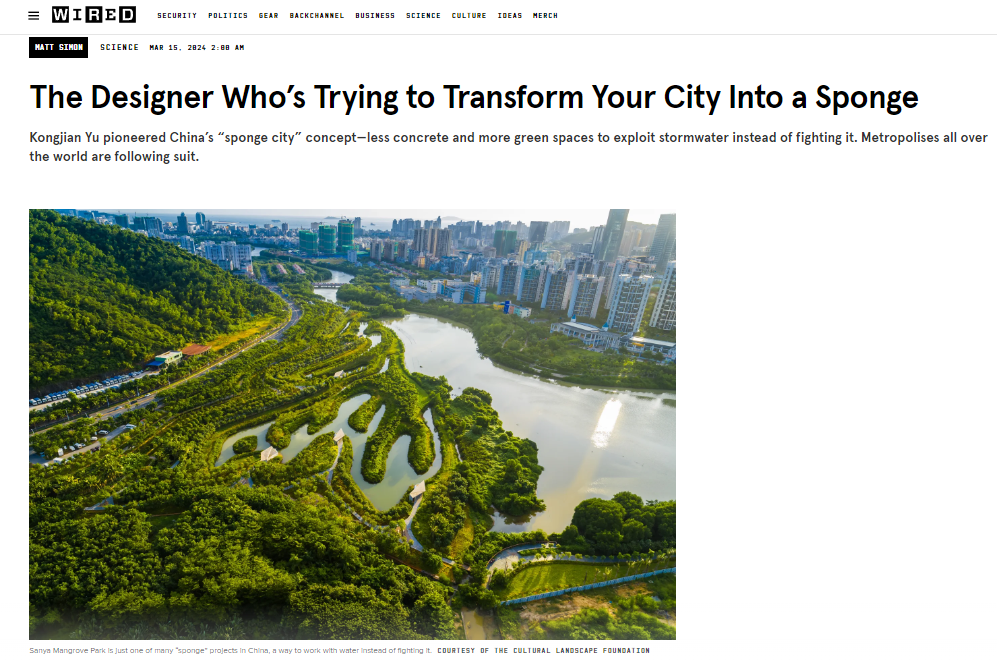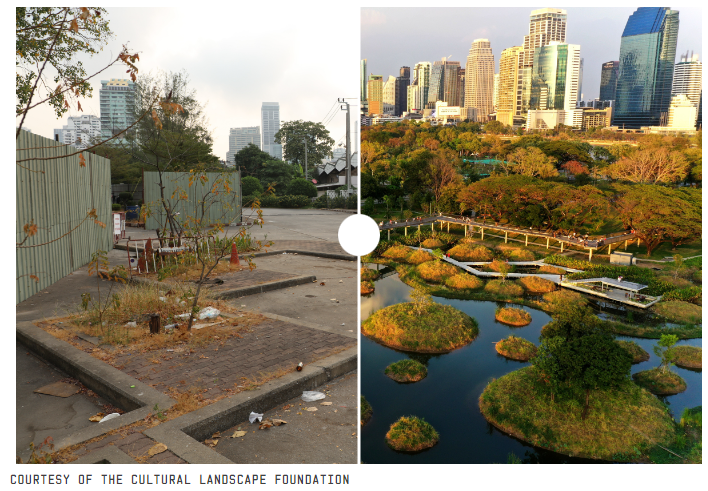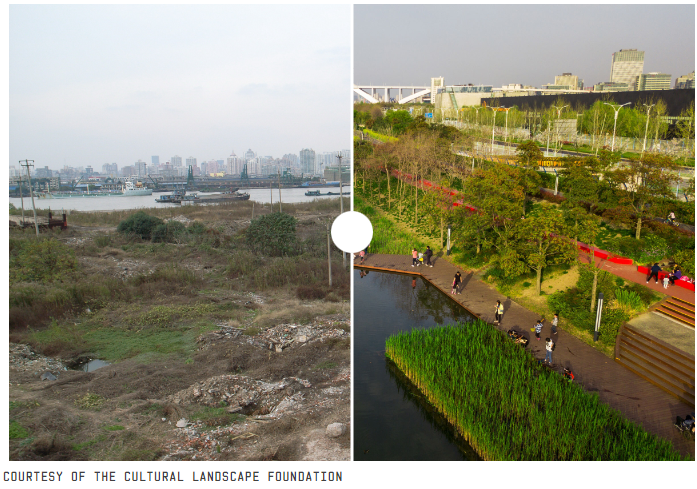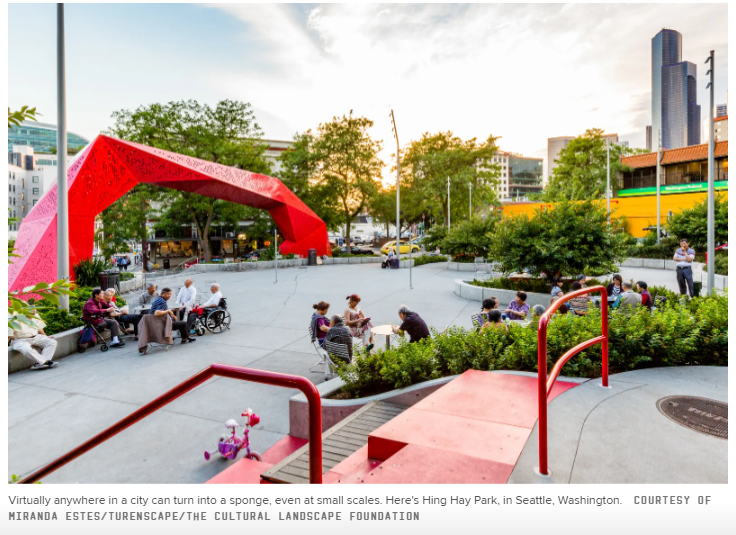Wired: 他正将城市转变为“海绵”

Your city isn’t prepared for what’s coming. The classical method for dealing with stormwater is to get it out of town as quickly as possible, with gutters and sewers and canals. But more and more, that strategy is breaking down: As the atmosphere warms, it can hold more moisture, spawning ever-wetter storms that overwhelm this creaky infrastructure. Your city was built for a climate of 100, 200, 300 years ago, but that climate no longer exists.
The hot new strategy in urban design, which was pioneered in China, is to slow everything down. Since 2013, China has embarked on a national policy to turn its growing metropolises into sponge cities, which capture stormwater instead of disposing of it all. If engineers can slow the flow of that water and allow it to soak into the Earth instead of running away—using rain gardens, spreading grounds, permeable pavers, and urban wetlands—that simultaneously reduces flooding and refills underlying aquifers. That’ll be increasingly critical as the planet warms and droughts intensify: Sponge cities aim to bank water for a rainy day, or more accurately, a parched one.
“Whenever rain falls, we retain as much as possible,” says Kongjian Yu, champion of the concept and founder of the Beijing design firm Turenscape. “We slow down the flow and let the earth take in the water. A sponge city will become an adaptive city, a resilient water system, a porous landscape.” A recent study found that, all told, cities across the United States could be soaking up billions of gallons of water a day in part by following China’s lead and accelerating sponge projects. “The sponge city is the urgent, immediate solution that can adapt cities to climate change, to heat, to floods, to drought,” says Yu.

This is what Benjakitti Forest Park, in Bangkok, Thailand, looked like before and after its sponge conversion. (Move the slider to see the full transformation.)
Following Yu’s recent award of the Oberlander Prize by the Cultural Landscape Foundation for his work on sponge cities, WIRED sat down with the landscape architect to talk about how to make urban areas as spongy as possible, how that can solve a whole lot of problems all at once, and what metropolises can do now to prepare for the increasingly chaotic climate of tomorrow. This conversation has been condensed and edited for clarity
WIRED: One thing that makes this concept so powerful is that you can do it on such different scales. In Los Angeles, they have spreading grounds—open areas hundreds of feet across where water is allowed to soak into the aquifer—but they’re also tearing up thin strips of roadside and putting in greenery.
Kongjian Yu: A sponge city can be on any scale. Water is precious. If you retain water in your backyard, you don’t have to water your trees, you don’t have to water your garden, because water is underneath—your treasure is here. It’s at a personal, individual, community scale.

On a regional, larger scale, we need a massive plan, to see where it’s possible to give water more space. It certainly has holistic benefits: You will have aquifer recharge, you will have beauty, which also increases the property values. And certainly it is supporting biodiversity.
Industrialized engineering solutions have messed up the whole water system globally. Everywhere, groundwater drops, and that eventually will cause big problems—huge problems, more than flooding.
You have to solve the problem holistically, and the sponge city is a nature-based, holistic solution. It is inexpensive, and it can be done at a small or large scale. You can have your garden, but you also have to plan from the top. It is a sponge planet, it is a sponge countryside, it is a sponge urban district.

The before and after of Shanghai Houtan Park, in Shanghai, China. (Move the slider to see the full transformation.)
What about the other big urban problem—heat?
If you have vegetation, you immediately lower the temperature dramatically, sometimes 5 degrees [Celsius] or even higher. In a very hot city, this difference can save lives. It can be a green roof, you can have a green wall, or you can have green ground—everywhere can be green. That not only reduces the light reflection, which creates heat, but also because of evaporation or transpiration, you actually reduce the temperature.
Urban gardens can produce food more locally, potentially reducing shipping emissions. Are you working on systems where you’re incorporating food production as well?
Yes, of course. With aquaculture, you can cultivate lotus ponds and rice—any kind of crops which you can combine with water management. This kind of project, because it’s wild in nature, it actually creates a new aesthetic. It’s not a normal garden, it’s not a normal park—it’s a productive park, it’s productive nature. Birds come back if you rewild.

Opportunities for sponge strategies have grown in China as its cities have grown. Is it harder to make an older city spongier, somewhere like LA or New York, compared to when you’re building more or less from scratch?
I don’t think so. Central Park can be a sponge. Los Angeles is a flat city, and you have so many gardens irrigated by water—just turn those gardens into sponges. It is just a mentality.
So we need to change how we think?
Yes. We believe that we can divert water from the Colorado River and we can use that water to irrigate, and we can flush away precipitation. For a long time, we’ve considered this to be civilized: We would pump away our sewage and a city becomes clean. We divert water into the city, and we irrigate a beautiful shiny lawn. We call this a civilization. No, that’s totally wrong, because we are running out of water.
What is your advice for a city—anywhere in the world—that might be looking to better manage its water in a warming climate and make the landscape better for human use?
The conventional stormwater solution, what we call gray infrastructure—concrete, pipes, and pumps, designed to flush away a flood as fast as possible—has failed, or will fail because of climate change. If you rebuild this infrastructure, you will make things worse, or you will fail again.
But if you come to the green alternative, you will not only save money, but the impact will be more immediate. The sponge city is basically using free nature. It’s simple. The problem is that it’s free. No one wants to invest in it, because no one can make money. That’s why I say that we need to change the business model. We need changes of policy, and we need changes of philosophy.
Source:https://www.wired.com/story/the-designer-whos-trying-to-transform-your-city-into-a-sponge/
